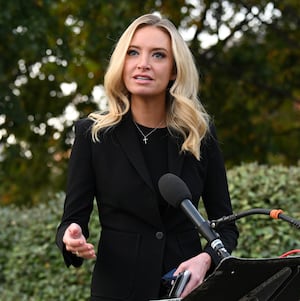Three days after a high fever and oxygen crisis put him in the hospital, coronavirus-infected Donald Trump returned to the White House and pulled off his mask for a photo-opportunity that was immediately turned into a video meant to show he had beaten COVID-19.
But even Trump’s own doctor concedes that he “may not entirely be out of the woods yet,” and the president appeared to be winded after climbing the steps to the White House to pose between two American flags.
Several staffers stood nearby as he tucked his mask into his suit pocket and saluted Marine One, which had landed on the lawn minutes earlier. At one point, he walked into the building—still not wearing a mask—and then returned to the balcony for a re-shoot.
ADVERTISEMENT
The display of optics over safety came hours after Trump—who has been given two experimental treatments and a heavy-duty steroid—tweeted a message that struck many as callous considering that almost 210,000 Americans have been killed by the virus.
“Feeling really good!” Trump tweeted on Monday afternoon. “Don’t be afraid of Covid. Don’t let it dominate your life. We have developed, under the Trump Administration, some really great drugs & knowledge. I feel better than I did 20 years ago!”
It also followed another public exercise in evasion and obfuscation by Trump’s physician, Dr. Sean Conley, who refused to answer questions about the president’s lung health, citing patient privacy laws even as he released other medical data that presented a rosier picture.
“Though he may not entirely be out of the woods yet, his team and I agree that all our evaluations—and most importantly his clinical status—support the president’s safe return home,” said Conley, telling reporters that the president would be “surrounded by world-class medical care 24/7.”

Details about Trump’s time at Walter Reed National Military Medical Center have been hard to nail down, but Conley belatedly admitted on Sunday that doctors decided to fly him there on Friday after his fever spiked and his oxygen levels dropped, requiring supplemental oxygen.
While still at the White House, he was given an experimental combination of two monoclonal antibodies. At Walter Reed, he got doses of the anti-viral drug remdesivir, and, on Saturday, the steroid dexamethasone, which can have serious side effects and is usually reserved for those with severe illness.
Doctors not working directly on Trump’s case have said that the combination of drugs disclosed by the president’s team suggests an infection that is far more serious than the White House has publicly acknowledged—and told The Daily Beast that Conley’s assertion that the president might not even be shedding live virus anymore is highly suspect.
“I don’t accept that for a minute,” said Lawrence Gostin, a law professor who specializes in public health law. “The CDC advises at least 10 days of self-isolation after all symptoms have abated and the patient has confirmed negative tests. This is a man who will have just gotten out of the hospital with a potentially severe case. Human health and life is at stake, and he probably infected others before going to the hospital. The morally and socially responsible action would be to self-isolate.”
None of the publicly stated details of Trump’s treatment or condition comported with the president’s sunny declaration that Americans should not be “afraid” of the deadly virus, which has infected more than a dozen members of Trump’s senior staff, advisers, and supporters in the past week. Even Conley, who has been a steadfast cheerleader for the president’s downplaying of COVID-19 in recent days, dodged answering a question about Trump’s suggestion that people not let an illness that has claimed nearly 210,000 Americans “dominate” their lives.
“I’m not gonna get into what the president says,” Conley said.
Conley repeatedly declined to say when Trump last tested negative for the coronavirus, and repeatedly cited the Health Insurance Portability and Accountability Act, which prevents the disclosure of sensitive medical details without a patient’s permission, as the reason he would not share information about whether the president has pneumonia.
“HIPAA kinda precludes me,” Conley said, from mentioning anything “he doesn’t wish to be discussed… for his own health and reasons.”
Those dodges were consistent with Conley’s past performances in front of the press. On Sunday, Conley admitted to reporters that he had obscured the fact that Trump had been given supplemental oxygen on at least two occasions in the past four days in order to present an “upbeat attitude” about the president’s condition, and floated the possibility that Trump could be released as early as Monday, despite indicating that Trump’s blood oxygen levels had dropped below the point of demarcation for a severe case of COVID-19, and that he had been prescribed a steroid that the World Health Organization recommends only for “severe and critical” cases.
At the time, Conley also sidestepped questions about whether Trump’s blood oxygen levels had ever dropped below 90 percent, as well as the specific results of lung scans, telling reporters that there were “some expected findings, but nothing of any major clinical concern.” Conley ignored follow-up questions inquiring what exactly those expected findings were.
Trump, who has spent months downplaying the pandemic in hopes of returning American to normality, has been agitating for a similar return to everyday life for himself in recent days. The White House itself has also put out pictures purportedly showing Trump at work—signing papers and apparently on work-related phone calls. On Sunday evening, Trump’s demands that he be discharged from Walter Reed reportedly grew so adamant that his medical team allowed him to ride in the back of a hermetically sealed Secret Service SUV—in contravention of the CDC’s own guidelines about the transport of COVID-19 patients being reserved for “medically essential” travel.
The decision to do that was widely seen as reckless—putting members of the president’s security detail in unnecessary danger and likely forcing those officials to have to quarantine—although Trump defended the decision in a tweet on Monday afternoon, saying that “media” would have called him “rude” had he not gone for the joyride.
“It is reported that the Media is upset because I got into a secure vehicle to say thank you to the many fans and supporters who were standing outside of the hospital for many hours, and even days, to pay their respect to their President,” Trump tweeted from the presidential suite at Walter Reed. “If I didn’t do it, Media would say RUDE!!!”
Asked about the car ride and whether it was safe for Secret Service agents, Conley said that the trip was “in line with everything that we’ve been doing upstairs for the last several days.”
What precautions the White House itself is now taking for Trump’s return is unclear, but health protocols dictate that a patient in his condition should remain in isolation.
The president reportedly began experiencing COVID-related symptoms sometime late last week and, according to the White House, he was diagnosed after attending a fundraiser in New Jersey on Thursday night.
The Centers for Disease Control and Prevention has put out guidance saying that “persons with mild to moderate COVID-19 remain infectious no longer than 10 days after symptom onset.” Trump, however, appears to be in a more elevated risk category. According to the CDC, “persons with more severe to critical illness or severe immunocompromise likely remain infectious no longer than 20 days after symptom onset.”
As Trump walked out of Walter Reed’s golden front doors just after 6:30 p.m. Monday, he ignored questions shouted by reporters about how many White House staffers were infected and whether it was safe for him to leave the hospital.
“Thank you very much,” he said, flashing a thumbs-up as he got into the motorcade that took him to Marine One for the quick flight back to the White House.
Soon after his homecoming, he tweeted a video of it, replete with soaring music, and a second video in which he boasted about how good he felt and reiterated his earlier message that the virus that has killed so many was nothing to fear.
“Don’t let it take over your life,” he said, later adding, “Now I’m better, and maybe I'm immune, I don’t know.”







